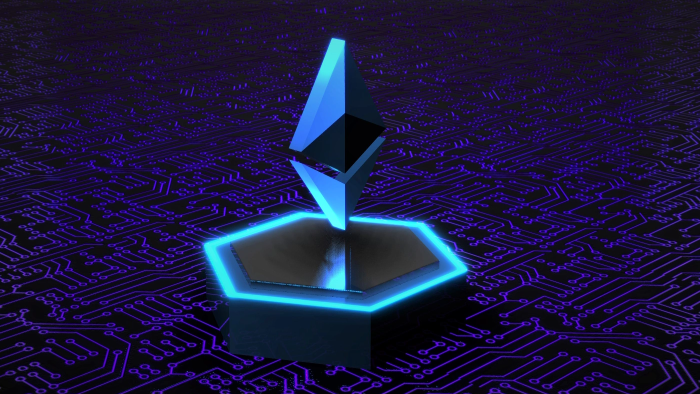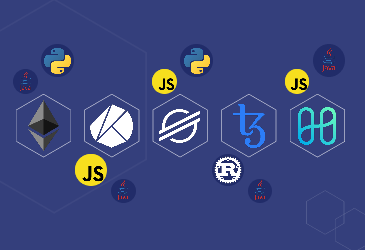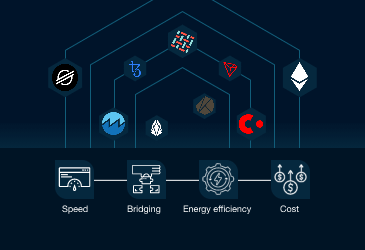
All about Ethereum
Vitalik Buterin first proposed Ethereum through a whitepaper in 2013. His aim was to build a next-generation smart contract and decentralized applications platform. The Bitcoin blockchain, at that time, was capable of the following-
-
Using on-chain virtual assets to represent custom currencies and financial instruments,
-
Non-Fungible assets,
-
Smart contracts, and
-
Blockchain-based DAOs.
However, Buterin wanted Ethereum blockchain to do more than what Bitcoin was capable of, and have more advanced features. Ethereum aspires to provide a blockchain with an inbuilt, full-fledged Turing-complete programming language that can be used to construct self-executing contracts, facilitating users and developers to build decentralized systems and much more simply with a few lines of code.
What is Ethereum?
Ethereum blockchain, as defined by the platform itself, “is a global, open-source platform for decentralized applications. On Ethereum, you can write code that controls digital value, runs exactly as programmed, and is accessible anywhere in the world.” It enables developers to create and deploy purpose-built decentralized applications and more. The Ethereum platform is not under the control of any single entity and exists through the decentralized participation and coordination of the Ethereum community.
The Ethereum blockchain introduced advanced smart contracts to make decentralization and self-execution of contract terms possible. It is the world’s first programmable blockchain where developers can build various applications for diverse use cases.
Ethereum uses a programming language known as Solidity, and Ether(ETH) is its native cryptocurrency which is used to pay for specific activities on the network, like paying the gas fees. Ether is currently the largest cryptocurrency after Bitcoin.
History of Ethereum
The history of Ethereum blockchain cannot be explained without touching upon its predecessor, Bitcoin. Introduced by an anonymous person or a group named Satoshi Nakamoto in 2008, Bitcoin proved to be a successful cryptocurrency. It enabled peer-to-peer transactions on a decentralized network without any third-party intervention. This was possible solely because of the technology on which it was built, blockchain.
However, the scope of the Bitcoin blockchain was limited to permissionless cross-border transactions. Besides, it had very basic smart contracts that could only execute Bitcoin transactions. Nevertheless, some developers like Vitalik Buterin found that this functionality of Bitcoin blockchain was undermining the real capabilities of blockchain technology. They realized blockchain had the power to unlock the true potential of decentralization. This was how Ethereum was born. Three major milestones of Ethereum development include:
-
November 27, 2013 – Vitalik Buterin released the Ethereum whitepaper.
-
April 01, 2014 – Yellowpaper of Ethereum was released, authored by Dr. Gavin Wood.
-
July 22, 2014 – September 02, 2014 – Ether’s Initial Coin Offering (ICO) campaign took place.
Architecture
Ethereum blockchain utilizes nodes run by volunteers to substitute individual servers and cloud systems used by conventional internet services. These nodes are computers containing a copy of the Ethereum network’s data, and perform specific network functions. Depending on the purpose, Ethereum blockchain offers three different types of nodes, which are:
-
Full Nodes keep and distribute the full copy of the blockchain data from the Ethereum network. It participates in blockchain validation and can directly deploy and interact with any smart contract on the public blockchain. However, running full nodes on Ethereum is quite expensive and energy-consuming.
-
Light Nodes manage less information. It handles basic information stored in a block like a timestamp or the previous block’s hash but can request more information if needed. They verify the validity of data but do not engage in block validation. As it does not execute complicated writing tasks and expensive data storage, it can efficiently be run on low-capacity devices like phones or PCs.
-
Archive Nodes hold similar data as a full node but archive each historical blockchain state. When a client has finished synchronization, full and light nodes “prune” the historical blockchain data, which means they can rebuild but never preserve this information. Archive nodes, however, can retain such historical data. These nodes can be utilized in block explorers, chain analytics and wallet vendors.
The Ethereum network utilizes the following other than Ethereum nodes, for various purposes:
1. Ethereum smart contracts
Ethereum introduced programmable smart contracts that later became irrevocable in the blockchain space. Ethereum smart contracts utilize arithmetic codes to initiate contracts between two parties without central control. These self-executed contracts automatically fulfill a predefined function on meeting a predefined condition. They are credible, trackable and irreversible, preventing human errors.
2. Ethereum Virtual Machine (EVM)
Ethereum Virtual Machine executes smart contracts on Ethereum, making it a ‘programmable’ network. It is an isolated machine that cannot access parts of the Ethereum code base like files or other processes. It is a single entity handled by thousands of connected computers that run an Ethereum client.
Ethereum smart contracts written in Solidity are sent to the Ethereum Virtual Machine for interpretation and execution. All Ethereum accounts and smart contracts live on the EVM runtime environment. It allows developers to use any programming language they prefer. Moreover, being Turing complete, it will find an answer if asked.
Consensus Mechanism
With the Ethereum merge on September 15, 2022, the Proof-of-Work mechanism utilized by the mainnet of the Ethereum blockchain is replaced with the Proof-of-Stake mechanism.
In the Proof-of-Stake mechanism, the validators lock up or stake their cryptocurrencies as collateral, or ETH, to validate the blocks. Anyone can stake their Ether, and candidates are chosen at random. The chosen validators are then in charge of confirming the validity of all transactions and freshly formed blocks. Anyone wanting to become a validator must run three different software—an execution client, a consensus client, and a validator—and deposit 32 ETH into the deposit smart contract. When a block is validated, the chosen validators are given block rewards or incentives for their contribution to the blockchain. However, if any validator operates maliciously or carelessly, their staked Ether may be lost. Thus, it is more secure than PoW.
Moreover, the PoS mechanism is less energy-consuming, offering more scalability and sustainability.
Technical Design
The Ethereum foundation visualized Ethereum as a decentralized computing platform that facilitates creating, storing, and running smart contract-based dApps.
An Ethereum network is a decentralized peer-to-peer (P2P) network of Ethereum clients representing network nodes. An Ethereum client can be any node that verifies new transactions, implement smart contracts and adds new blocks to the chain. It can be considered an enclave living in thousands of computers on the internet while connected via the Ethereum P2P network. The enclaved network is the EVM and the runtime environment in the P2P network that execute Ethereum smart contracts.
The EVM is run by Ethereum clients, which can be built in any popular programming language. For dApps engaging with an Ethereum blockchain, Ethereum clients provide a set of web3 APIs through JSON-RPC. To interact with the Ethereum network from your web or wallet application, use the web3 object supplied by the web3.js framework. It is compatible with all Ethereum clients. It interacts with a local or remote Ethereum node and makes RPC calls in the backend.
To dApps, the Ethereum network resembles a massive global computer made up of thousands of computing processors spread over the internet. Once connected to the internet, you can interact with any node in the decentralized system.
Founders
Vitalik Buterin, a Russian-Canadian programmer, first proposed the concept of Ethereum blockchain and is considered the network’s founder. The white paper for Ethereum was published in 2013, and the project was launched in 2015. The co-founders of Ethereum who have contributed to the development of the blockchain include:
-
Mihai Alise – Alise assisted in setting up a legal framework for the pre-sale of ETH.
-
Anthony Di Iorio – He served as one of the financial sponsors of the Ethereum startup before the team decided to take a non-profit business principle.
-
Amir Chetrit – Much about Amir Chetrit’s contributions to the network is unknown and remains mysterious to the public.
-
Charles Hoskinson – He aided mostly in setting up the Swiss foundation and its legal framework and was an early advocate of Ethereum. He later founded Cardano.
-
Gavin Wood – He contributed to the early programming and architecting of Ethereum and composed its yellow paper. He is the founder and CEO of Parity technologies.
-
Jeffrey Wilcke – His programming contributions to the network gave birth to a software implementation known as Go Ethereum, abbreviated Geth.
-
Joseph Lubin – He is speculated to be one of the top buyers in the Ethereum crowdsale. He actively engaged in setting up a non-profit Ethereum Foundation to ensure the network works fairly and independently. Later, he founded a company, ConsenSys, that developed the Ethereum-compatible wallet, MetaMask.
Although Ethereum was co-founded by a team of the above eight developers and entrepreneurs, only Vitalik Buterin is actively working on this second-largest cryptocurrency project. The rest of the teams have moved on to build their own projects.
Popular Use Cases
-
Decentralized Finance (DeFi) – Ethereum blockchain can be considered the pioneer of DeFi, where you can conduct a transaction anywhere in the world without any intermediary intervention. Ethereum DeFi enables borrowing funds, trading tokens, raising funds, and more.
-
NFT – One of the major use cases of Ethereum is NFT, which has gained immense prominence in today’s time. An NFT can have one official owner at a time, and the Ethereum blockchain completely secures them. The Ethereum network also makes it impossible to modify or duplicate the ownership.
-
Decentralized Autonomous Organizations (DAO) – It is a blockchain-based community without centralized leadership. Everything in DAO, including fund management and money flow, is handled by DAO codes that provide transparency and a tamper-proof environment.
Ethereum merge
Since the introduction of Ethereum, it has utilized the Proof-of-Work consensus mechanism, similar to Bitcoin. However, it fell behind in offering the required throughput and needed heavy computational power for mining. So, the team behind Ethereum introduced another chain known as the Beacon chain that runs parallel to the mainnet and depends on the Proof-of-Stake mechanism to achieve consensus.
On September 15, 2022, the Beacon chain was merged with the mainnet, and the PoS mechanism permanently replaced its original consensus algorithm, PoW. This event, known as the merge, marks a revolutionary change in the history of Ethereum development. This upgradation officially introduced PoS as its consensus mechanism, reducing the power consumption by 99.5% and offering possibilities of more scalability, sustainability and security while preserving its core value of decentralization.
If you want to know the performance of the Ethereum network, its ecosystem score and ranking, the foundation tools it provides, and more, you can check out the Ethereum review and rating on Scortik.
Insights

What are SDKs? Top blockchains and their SDKs
A software development kit or SDK is a set of tools and programs utilized to build and integrate customized applications for any existing or new platform.

How to Choose a Blockchain Protocol Suitable to Your Project?
Need help choosing the right blockchain protocol for your project? Use Scortik to evaluate protocols’ overall performance and make the right choice.

WanChain: Empowering Blockchains With Interoperability
Wanchain is a blockchain interoperability and decentralized finance platform that connects multiple blockchains with one another.